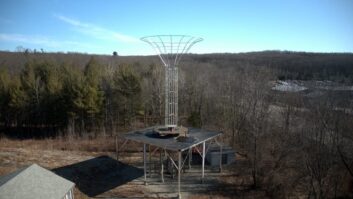Last year the FCC changed its rules to make it significantly easier for FM radio broadcasters to verify their directional patterns.
The report and order gives FM and low-power FM applicants using directional antennas the option to verify their directional pattern with computer modeling of the directional antenna pattern performed by the directional antenna’s manufacturer. Previously, the rule required the performance proof of an FM or LPFM directional antenna to be verified by costly, time-consuming actual filed pattern measurement.
As recognized by Chairwoman Rosenworcel, more than a fifth of FM radio stations use directional antennas, but FCC rules required a very expensive and difficult method to prove the array by physical measurement.
Prior to the new rule, FM radio stations using directional antennas were either required to provide actual measurements of the radiated signal to verify their directional pattern utilizing a full-size mockup or scale model of the antenna. Both are expensive to complete. Further there were several difficulties with conducting the physical measurement, such as accurately replicating the installed antenna environment, including nearby structures, that could affect the radiated pattern.
A properly implemented computer model can take these factors into account and provide a more accurate and less-expensive pattern verification.

Engineer qualifications
Initially, the commission proposed that the license applicant must provide details of the software tools used in modeling the antenna’s directional pattern, the process by which the computer modeling was carried out and the qualifications of the engineer who designed, modeled and provided installation instructions for the directional antenna.
However, the commission was persuaded that this would be too cumbersome and concluded to allow license applicants to verify the directional antenna patterns by submitting results from computer models depicting the antenna’s performance generated by the antenna’s manufacturer.
In reaching its conclusion, the commission noted that AM and DTV licensees both have the option of relying on computer modeling for directional antenna performance verification. It decided that allowing FM applicants similar flexibility would be appropriate here.
The commission explained that relying on the antenna manufacturer to validate directionality via computer modeling was unlikely to cause problems. Manufacturers are able to ensure the validity of the computer model and the accuracy of the results, and manufacturers can be relied upon to use engineers possessing the required expertise. Given the varying backgrounds of broadcast engineers, it declined to codify computer modeling qualifications, noting that, should a challenge arise, for example, in the nature of interference complaints, it would seek further information regarding the broadcaster’s model, including the qualifications of those who prepared and performed the modeling.
While there is no limitation on those who can perform computer modeling for AM and DTV directional antennas, the commission declined to grant similar flexibility to FM applicants. FM applicants will be required to use manufacturer modeling because there are a greater number of FM stations, as compared to DTV stations using directional antennas, and it is not possible to subject FM directional antennas to continual verification through sampling, unlike AM directional antennas.
The Application
Antenna manufacturers may use either commercially available modeling software or their own proprietary software provided it meets the requirements. FM applicants for a directional antenna are required to ensure the following information is provided for each option:
- Commercial software: The manufacturer’s report must identify which commercially available modeling software the manufacturer utilized to verify the antenna directional pattern.
- Manufacturer custom software: The submission must include a description of the software and the computational methods underlying the software sufficient to replicate the results if necessary.
Broadcasters must ensure that the model analyzes the antenna as mounted on their proposed tower or tower section. The digital model of the tower or tower section must include existing transmission lines, appurtenances, ladders, conduits, other antennas, and any other installations that could affect the directional pattern. The submission statement, which as noted below will be prepared by the engineer and submitted with the application, must also list and describe all such elements and structures included in the model.
In addition to information on the type of software, the application also must include:
- A statement setting forth the name(s) and qualifications of the engineer(s) who designed the antenna, performed the modeling, and prepared the manufacturer’s instructions for installing the antenna.
- A statement from such engineer(s) identifying and describing the software tools used in the model and the procedures used in running the software.
- A certification that the software executed normally without generating any error messages or warnings indicating any problem with the inputs.
- Verification of the accuracy of the pattern generated using the particular modeling software for each directional antenna model number or standardized series of elements.
- A certification from the engineer responsible for installing the antenna that the antenna has been installed pursuant to the manufacturer’s instructions, and verification from a licensed surveyor, that the antenna is properly oriented.
Previously verified antennas
To promote efficiency and ease the burden on FCC staff, once a particular antenna model or series of elements has been verified by any license applicant using a particular modeling software, the commission will permit all subsequent license applicants using the same antenna model number or elements and using the same modeling software to cross-reference the original submission by providing the application file number.
Interference complaints
The commission dismissed concerns from antenna manufacturer ERI that modeled pattern verification could lead to increased interference once installed, believing this was sufficiently addressed through modeling software verified by measurements requirements, but reaffirmed its policies regarding the need to address interference complaints or disputes.
Conclusion
FM license applicants now have the option of submitting computer-generated proofs of FM directional antenna patterns from the antenna’s manufacturer in lieu of measured pattern plots and tabulations, a far simpler and less expensive option.
Applicants may still submit measured relative field patterns rather than computer modeled patterns if they so desire, but the revised rules should ease the burden on FM directional applicants.
This column is provided for general information purposes only and should not be relied upon as legal advice pertaining to any specific factual situation. Legal decisions should be made only after proper consultation with a legal professional of your choosing.







